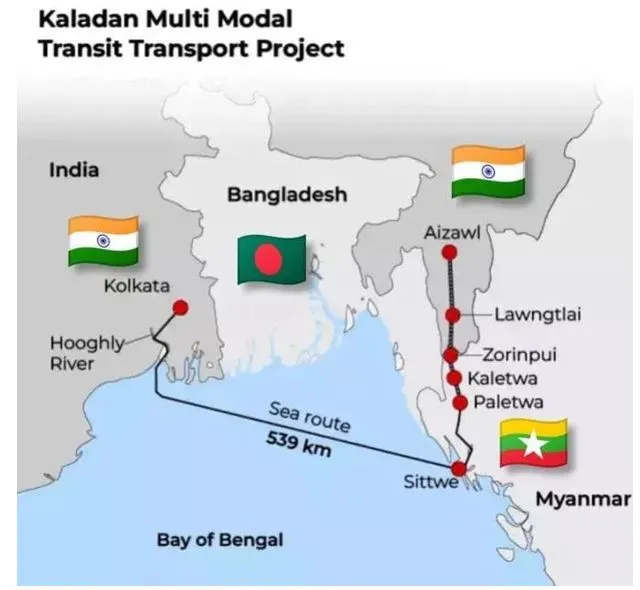

19th May 2025 (13 Topics)
Context
India has imposed new port restrictions on imports from Bangladesh—especially on ready-made garments—following Bangladesh's move to block Indian yarn exports via land ports. This marks a significant escalation in trade tensions between the two neighbours.
What has Triggered Recent Trade Friction?
- Restrictions on Garments from Bangladesh: India restricted imports of Bangladeshi garments to protect its domestic textile industry and attract labour-intensive manufacturing jobs to its own economy. Indian manufacturers have long complained that Bangladesh enjoys unfair price advantages, due to:
|
Indian Seaports Allowed for Certain Bangladesh Exports:
|
- Duty-free fabric imports from China
- Export subsidies by the Bangladeshi government
- No GST on imported inputs (compared to India’s 5% GST on fabric)
- Termination of Transhipment Facility: India ended a five-year-old transhipment arrangement that allowed Bangladesh to use Indian ports and land routes to export goods to third countries. This was a key logistics channel for Bangladesh’s trade with the West, especially the EU and UK.
- Bangladesh's Port Restrictions: Bangladesh has restricted India’s yarn exports via land ports, now allowing only seaport-based exports. Yarn is vital for Bangladesh’s garments industry, and land ports offer quicker, cheaper access.
Concerns for India
- Regional imbalance: This deterioration is not just about trade; it’s also about strategic influence and regional balance. India sees Bangladesh as a key buffer and partner in the Northeast. Any shift in Dhaka’s foreign alignment directly affects India’s security, connectivity projects, and regional diplomacy.
- Loss of Influence in a Key Neighbour: Bangladesh’s pivot to China could undermine India’s leadership role in the region. It may impact India’s Act East and Neighbourhood First policies.
- China Involvement: China has given duty-free access to 97% of Bangladeshi exports since 2020. It has invested heavily in infrastructure (roads, ports, bridges) and is also Bangladesh’s main military supplier. A USD 2.1 billion deal signed in March 2025 further cemented this strategic realignment. Chinese involvement in sensitive projects like the Teesta River development adds to India’s concern
- Regional Trade Competition: China’s support helps Bangladesh stay competitive in garments, even as India tries to boost its own exports under new FTAs. India could lose out on labour-intensive FDI if it doesn’t become more cost-effective.
Benefits for India
- Protecting Domestic Industry: By limiting cheap imports from Bangladesh, India aims to:
- Boost its own textile manufacturing
- Attract labour-intensive jobs
- Ensure a level playing field for Indian manufacturers
- Reviving Northeast India’s Industry: Bangladeshi imports through land ports in the Northeast stifle local industry and limit trade to basic agricultural produce. By restricting imports via these routes, the government aims to promote self-reliance (Atmanirbhar Bharat) and encourage industrial development in the region.
- Rebalancing the Trade Relationship: Bangladesh cannot “cherry-pick” trade benefits while restricting Indian exports. The withdrawal of the transshipment facility, which allowed Bangladesh to export to third countries through Indian ports and airports, is also part of this rebalancing effort.
- Access to key markets: India is signing FTAs with the UK, EU, and EFTA to build alternative garment export routes. This also explains why it is less dependent on Bangladeshi textile imports now.
- Kaladan Multi-Modal Transit Transport Project: This shift has forced India to revive and fast-track alternate routes, particularly through Myanmar, via the Kaladan Multi-Modal Transit Transport Project (KMMTTP). KMMTTP, launched in 2008 as part of India’s Look East/Act East Policy, this project is a multi-modal connectivity initiative that links:
- Kolkata (India) to Sittwe Port (Myanmar) by sea (539 km)
- From Sittwe to Paletwa via the Kaladan river (158 km)
- Then by road to Zorinpui (Mizoram) through a 108 km highway
- Finally, it connects to Aizwal and Shillong via existing and planned roads
- Zorinpui is the India-Myanmar border point in Mizoram.
- This route bypasses Bangladesh entirely and can cut travel time by 3–4 days and reduce distance by 1,000 km compared to traditional routes through Siliguri.

India-Bangladesh Relations
|

